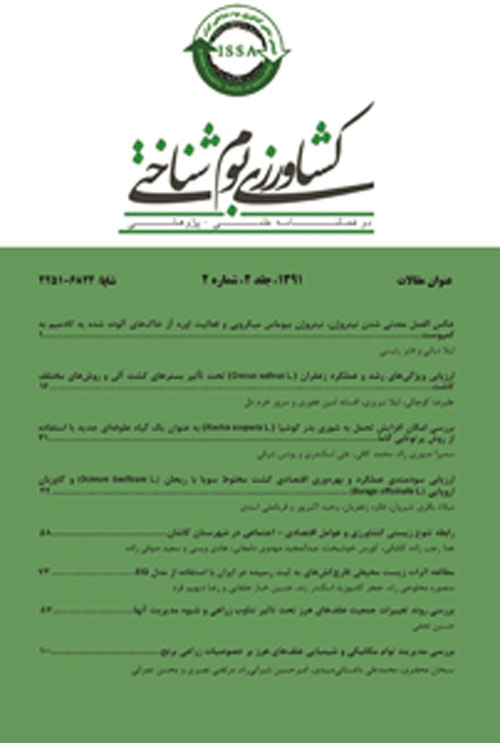Response of sweet basil and borage to weeds and mung bean and persian clover cover crops
Author(s):
Article Type:
Research/Original Article (دارای رتبه معتبر)
Abstract:
Introduction
The value of medicinal plant production depends on plant quality. Stability, on the other hand, is less important. Because they compete for light, soil moisture and nutrients, weeds can reduce the yield of medicinal plants (Uchino et al., 2009). Using herbicides for weed control increases species resistance, environmental problems and costs (Sadeghi et al., 2003). An alternative weed control method, however, is the use of cover crops (Compigla et al., 2010) which have a vital role in sustainable agriculture, soil conservation and a healthy environment. Thus, we can select suitable species according to their physical and chemical properties for competition and ability to suppress weeds. The aim of this research is to investigate the role of two cover crops, mung bean (Vigna radiate L.) and Persian clover (Trifolium resupinatum L.) on weed control of sweet basil (Ocimum basilicum L.) and borage (Borago officinalis L.).
Materials and methods
Two field experiments were carried out in a randomized complete block design with three replications. In the first experiment, treatments included cover crops in the rows between the sweet basil while in the second one in the rows between the borage. Moreover, pure stand of sweet basil and borage without cover crops with weed infestation and weed free were used as controls for both experiments. The plots with cover crops included five rows of medicinal plants (in 50-cm row spacing with 5 cm between sweet basil plants and 20 cm between borage plants in the same row) and six rows of cover crops. The cover crop was inter-seeded simultaneously with the main crop.
Results and discussion
The results showed that a pure stand of sweet basil and borage in a weed free section had the highest number of leaves, stem diameter and fresh and dry weight. On the other hand, there was minimal fresh and dry weight of sweet basil and borage in the presence of mung bean as a cover crop. Moreover, the presence of mung bean also minimized values for all morphological traits of sweet basil and borage. Maximum essential oil concentration and yield in sweet basil and borage were observed in pure stand with no weed interference. The mung bean cover crop was more successful in suppressing weeds compared to Persian clover and a further reduction in weed density and biomass was measured when it reduced the density and biomass of weeds in the sweet basil and borage from 50% to 100% in the first to third sampling. The results also showed that sweet basil and borage could not compete with mung bean in terms of the ability to withstand competition (AWC) with weeds.
Conclusion
The conclusion is that using cover crops reduces weed growth, which can control weeds. Mung bean was more successful in suppressing weeds compared to Persian clover in sweet basil and borage farms, because it decreased weed density and biomass.Keywords:
Language:
Persian
Published:
Journal of Agroecology, Volume:8 Issue: 2, 2018
Pages:
29 to 46
magiran.com/p1916843
دانلود و مطالعه متن این مقاله با یکی از روشهای زیر امکان پذیر است:
اشتراک شخصی
با عضویت و پرداخت آنلاین حق اشتراک یکساله به مبلغ 1,390,000ريال میتوانید 70 عنوان مطلب دانلود کنید!
اشتراک سازمانی
به کتابخانه دانشگاه یا محل کار خود پیشنهاد کنید تا اشتراک سازمانی این پایگاه را برای دسترسی نامحدود همه کاربران به متن مطالب تهیه نمایند!
توجه!
- حق عضویت دریافتی صرف حمایت از نشریات عضو و نگهداری، تکمیل و توسعه مگیران میشود.
- پرداخت حق اشتراک و دانلود مقالات اجازه بازنشر آن در سایر رسانههای چاپی و دیجیتال را به کاربر نمیدهد.
In order to view content subscription is required
Personal subscription
Subscribe magiran.com for 70 € euros via PayPal and download 70 articles during a year.
Organization subscription
Please contact us to subscribe your university or library for unlimited access!


